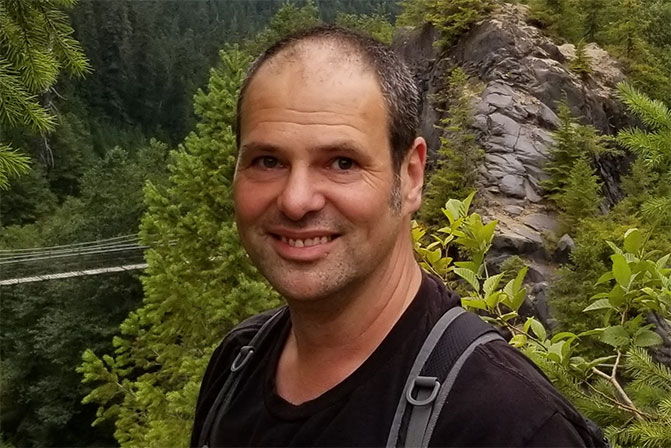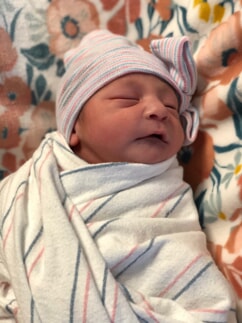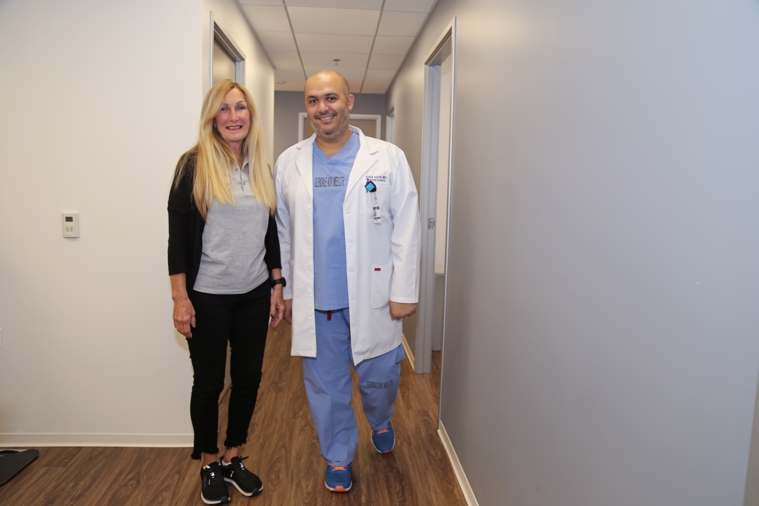Mystery Bystander Saves a Life With CPR
Feb 1, 2024

Saved by a stranger
It’s a crisp Monday morning in Gresham, Oregon, and the sun has yet to crest the horizon. James Munson, 42, heads out the door, hops on his bike and starts his daily 7-mile ride to work. Along the Springwater Corridor Trail he rides, flanked by damp ferns, quiet woods, sleepy creatures, and the stillness of dawn.
How time flies, James ponders to himself. Seems like yesterday his eldest daughter was born. Today she turns 16, and he can hardly wait to see her and celebrate. Lost in thought, he pedals on, planning to work a half day, then fly to the East Coast with his younger daughter, age 4, for the party.
“That’s the last memory I have,” James says. “I was on the trail, and then I woke up and it was a couple days later. When I was finally lucid enough to figure out that I was in a hospital, the only thing I could think of was that maybe I had been hit by a car.”
Actually, James had blacked out, crashed his bike and experienced a sudden halt in his heartbeat. He could have lost his life. Instead, a total stranger saved it.
Unknown hero
As the details emerged, James learned he’d had a sudden cardiac arrest on his way to work. One of his heart’s arteries was 90% blocked. An ambulance took him to Adventist Health Portland, where he had an emergency procedure by cardiologist Dr. Mark Hart. A stent, or small mesh tube, was placed in James’ heart to hold open the narrowed artery and help restore blood flow. During his recovery, relieved family members streamed in and out of the room as nursing staff tended to his care and comfort.
But as the story unfolded, one mystery remained: In the critical time between when James crashed and medics arrived, someone saw him go down and rushed to his rescue.
“To this day I don’t know who it was. But I do know I’m alive thanks to the kindness and efforts of a complete stranger,” James says. “They did CPR on me before the medics got there. It must have been immediate, because Dr. Hart didn’t detect any damage to my heart tissue or brain functions.”
CPR, or cardiopulmonary resuscitation, is an emergency lifesaving procedure performed when a person’s heart stops beating, such as after cardiac arrest, the American Heart Association says. Keeping a person’s blood flow active, even partly, extends the chance for resuscitation after trained medical staff arrive.
In James’ case, CPR truly made all the difference. “Basically, I dropped dead, and someone saved me,” James says. “It wasn’t the paramedics because they wouldn’t have been there in time. Someone saw me go down, pulled over their car or whatever, and ran straight to me. Whoever it was, they did it fast. I have a strong functioning heart because they got to me quickly.”
In addition to that person, James also praises the swift and skilled response of the medics, hospital staff and Dr. Hart. He thanks family and friends who helped him during a scary time.
Paying it forward
After James got home from the hospital, he and his partner tried to find the person who saved him so they could express their heartfelt thanks. Sadly, no one responded to the sign they posted at the intersection.
Years later, James still wonders: Is that person out there? Could they be nearby? If James were to somehow meet that mystery hero, he’d be overwhelmed with gratitude.
“I’d tell them I’m alive due to your kindness and consideration. Not only that, I’m alive because of your forethought in getting trained [in CPR],” James says. “You not only saved a life, but you did it with intention.”
What’s more, James adds, as a dad, there’s no way to measure how thankful he is to be alive and well for his kids all these years. “I’d tell whoever saved me that a lot has happened in my life since then, and I’m still functioning at full capacity,” James says. “I don’t feel debilitated in any way. Not only did you save me, you saved my quality of life too.”
In the weeks after James’ cardiac arrest, tests showed no sign of tissue damage or a weakened heart. Within a couple months, Dr. Hart gave James the green light to resume an active lifestyle, adding that it was key to keeping his heart strong. Every chance he gets, James enjoys a good hike. He also bought a new bike and started riding to work again.
As for CPR, James admits he didn’t know the procedure before his life depended on it. “But after my cardiac arrest, I learned it and I continue to stay certified,” he explains. “I would be happy to return the favor if it’s ever needed.”
At his job as an electrical/mechanical technician, James convinced his bosses to buy an automated external defibrillator for the shop. AEDs are medical devices that can analyze the heart’s rhythm and, in a cardiac arrest, deliver an electric shock to help the heart reestablish an effective rhythm.
James also persuaded his coworkers to learn CPR. “I’m a lead over a crew, and to be honest I kind of guilted them into it,” he says. “I told them ‘Look, I’m here because somebody did CPR on me.’”
Ultimately, everyone in the crew got CPR certified — and they were allowed to learn on work time. James’ now-adult children are also trained in CPR.
If there’s one, there’s more
James’ cardiac event touched not only his heart, but his thoughts as well. “We tend to think we live in a cynical world where everything is done for money and not much else,” he says. “But we shouldn’t forget that great things still happen. People aren’t always as detached as they get accused of. They really step up. People are out there who care.”
He hopes others, including his kids, understand that everyone can make a difference. “I personally can tell you that there are good people in the world, and I’m alive because of one,” he says. “And if there’s one, there’s more.”
Related articles

It’s a girl at the Adventist Health Tulare Birth Center! First baby arrives to cheers, tears
September 10, 2019

A “princess” leaps into the world on Leap Day!
March 1, 2020

Grateful volunteer: Former patient giving back to the hospital that saved her life
January 29, 2019